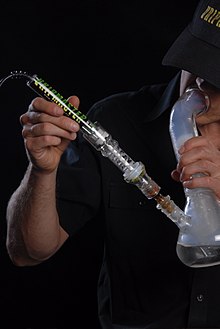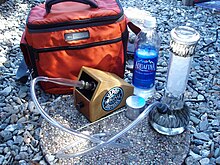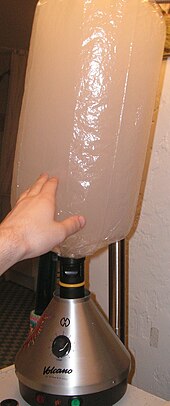User:Onepex/sandbox

A vaporizer or vaporiser is a device used to vaporize the active ingredients of plant material, commonly cannabis, tobacco, or other herbs or blends for the purpose of inhalation. However, they can be used with pure chemicals when mixed with plant material (e.g. nicotine-free tobacco).
Vaporization is an alternative to burning (smoking) that avoids the inhalation of many irritating toxic and carcinogenic by-products.[1]
Vaporizers contain various forms of extraction chambers including straight bore, venturi, or sequential venturi, and are made of materials such as metal or glass. The extracted vapor may be collected in a jar or inflatable bag, or inhaled directly through a hose or pipe. With little to no smoke produced and cooler temperatures,[2] less material is required to achieve a given level of effect.[3] Hence, the irritating and harmful effects of smoking are reduced,[4][5][6][7][8] as is secondhand smoke.



Marijuana vaporizers[edit]

Vaporizers are also used to inhale marijuana. Of the studies about vaporizing marijuana, few have addressed the quality of the vapor extracted and delivered; instead, studies usually focus on the mode of usage of the vaporizers. There are 483 identifiable chemical constituents known to exist in the cannabis plant,[9] and at least 85 different cannabinoids have been isolated from the plant.[10] The aromatic terpenoids begin to vaporize at 126.0 °C (258.8 °F),[11] but the more bio-active tetrahydrocannabinol (THC), cannabidiol (CBD) and cannabinol (CBN) do not vaporize until near their respective boiling points: THC 157 °C (315 °F),[12] CBD 160–180°C (320°F-356°F),[12] and CBN 185 °C (365 °F)[12]
Vaporizers for medical use[edit]

Studies have shown that vaporizing cannabis exposes the user to lower levels of harmful substances than smoking cannabis.[13][14][15][16] These findings are important for it is estimated that 10–20 percent of patients with chronic pain, multiple sclerosis, epilepsy, and HIV/AIDS have admitted to smoking cannabis for therapeutic purposes.[17] For patients, a study found that smoking cannabis sativa reduced daily pain by 34%, a statistically significant amount.[18]
In a study published in the Journal of Psychopharmacology in May 2008, it was stated that vaporizers were a "suitable method for the administration of THC."[19] A 2007 study by University of California, San Francisco, published in the Journal of the American Academy of Neurology, founded that "there was virtually no exposure to harmful combustion products using the vaporizing device."[7] A 2006 study performed by researchers at Leiden University found that vaporizers were "safe and effective cannabinoid delivery system(s)." The study stated that the amount of THC delivered by vaporizers were equivolent to the amount delivered by smoking.[16] Because of those studies and other studies, vaporizers are medically sound devices for delivering THC.[20]
Efficiency[edit]
The proposed factors affecting output include:[13][16]
- Temperature
- Specimen density
- Weight, content of water and essential oils
- Consistency of material in the filling chamber
- Storage time of the vapor
- Inhalation method (breathing technique)
Not all those have been scientifically tested. Research using vaporizers found the delivery efficiency highest at around 226 °C (439 °F), falling to about half efficiency at 150 °C (302 °F) to 180 °C (356 °F) degrees depending on material.[16] The purest preparations produced the highest efficiencies, about 56% for pure THC versus 29% for plant material (female flower tops) with 12% THCA content. Besides THC, several other cannabinoids as well as a range of other plant components including terpenoids were detected in the plant material. Using pure THC in the vaporizer, no degradation products (delta-8-THC (D8-THC), cannabinol (CBN), or unknown compounds) were detected by HPLC analysis.[16] The longer vapor is stored, the more THC is lost as it condenses on the surface of the vaporizer or the balloon. This loss may be negligible over a few minutes but may exceed 50% after 90 minutes.[16] The Leiden University study found that as much as 30%–40% of inhaled THC was not absorbed by the lungs but simply exhaled. However, they did not find large individual differences in the amounts exhaled.[16]
Culinary application[edit]
Vaporizers are sometimes used by chefs as a method of applying controlled heat to herbs and spices to release flavors that are otherwise difficult to titrate or apply, or that might be spoiled by overheating during cooking.[21][22][23] Grant Achatz, chef-proprietor of Alinea in Chicago, "uses the aroma-filled bags as place-mats, punctured when plates are placed in front of the customer."[21]
See also[edit]
References[edit]
- ^ Hugh C. Hemmings, Philip M. Hopkins (2006). Foundations of Anesthesia: Basic Sciences for Clinical Practice. Elsevier Health Sciences. p. 325. ISBN 0323037070.
- ^ Stephen A. Greene (2002). Veterinary Anesthesia and Pain Management Secrets. 74: Elsevier Health Sciences. ISBN 1560534427.
{{cite book}}: CS1 maint: location (link) - ^ "Get Educated Before You Buy Vaporizers". Retrieved 3 March 2014.
- ^ Earleywine M, Barnwell SS (2007). "Decreased respiratory symptoms in cannabis users who vaporize". Harm Reduction Journal. 4: 11. doi:10.1186/1477-7517-4-11. PMC 1853086. PMID 17437626.
{{cite journal}}: CS1 maint: unflagged free DOI (link) - ^ "Vaporizers for Medical Marijuana". www.aids.org. Archived from the original on 2010-07-18. Retrieved 2008-07-28.
- ^ Grotenhermen F (June 2001). "Harm Reduction Associated with Inhalation and Oral Administration of Cannabis and THC". Journal of Cannabis Therapeutics. 1 (3 & 4): 133–152. doi:10.1300/J175v01n03_09.
- ^ a b Abrams DI, Vizoso HP, Shade SB, Jay C, Kelly ME, Benowitz NL (November 2007). "Vaporization as a smokeless cannabis delivery system: a pilot study" (PDF). Clinical Pharmacology and Therapeutics. 82 (5): 572–578. doi:10.1038/sj.clpt.6100200. PMID 17429350.
{{cite journal}}: CS1 maint: multiple names: authors list (link) - ^ "The Centennial Celebration – Washington, D.C. September 13–17, 1948". Science. 108 (2800): 205–206. August 1948. doi:10.1126/science.108.2800.205. PMID 17821306.
- ^ "What chemicals are in marijuana and its byproducts?". ProCon.org. 2009. Retrieved 2013-01-13.
- ^ El-Alfy; Abir T; et al. (Jun 2010). "Antidepressant-like effect of delta-9-tetrahydrocannabinol and other cannabinoids isolated from Cannabis sativa L". Pharmacology Biochemistry and Behavior. 95 (4): 434–42. doi:10.1016/j.pbb.2010.03.004. PMC 2866040. PMID 20332000.
{{cite journal}}: Cite has empty unknown parameter:|author-separator=(help); Explicit use of et al. in:|author3=(help); Unknown parameter|displayauthors=ignored (|display-authors=suggested) (help) - ^ "Methods of Medicating with Marijuana". evaluationtoday.com. Retrieved 10 February 2014.
- ^ a b c http://www.cannabis-med.org/data/pdf/2001-03-04-7.pdf
- ^ a b Gieringer, Dale; St. Laurent, Joseph; Goodrich, Scott (9 February 2004). "Cannabis Vaporizer Combines Efficient Delivery of THC with Effective Suppression of Pyrolytic Compounds" (PDF). Journal of Cannabis Therapeutics. 4 (1). Haworth Press: 7–27. doi:10.1300/J175v04n01_02. Retrieved June 20, 2010.
- ^ "Marijuana Vaporizer Provides Same Level Of THC, Fewer Toxins, Study Shows", Official Journal of the American Academy of Neurology (summarized by Science Daily) (2007-05-16)". Sciencedaily.com. 2007-05-16. Retrieved 2011-02-23.
- ^ "Cal NORML/MAPS Study Shows Vaporizer Can Drastically Reduce Toxins in Marijuana Smoke". Canorml.org. Retrieved 2011-02-23.
- ^ a b c d e f g Hazekamp A, Ruhaak R, Zuurman L, van Gerven J, Verpoorte R (June 2006). "Evaluation of a vaporizing device (Volcano) for the pulmonary administration of tetrahydrocannabinol". Journal of Pharmaceutical Sciences. 95 (6): 1308–17. doi:10.1002/jps.20574. PMID 16637053.
{{cite journal}}: CS1 maint: multiple names: authors list (link) - ^ "Biomechanics Of Vaporizers". VN. 4 February 2014. Retrieved 9 February 2014.
- ^ Barohn, Richard (2013). Peripheral Neuropathies, An Issue of Neurologic Clinics. Elsevier. ISBN 978-1455771226.
- ^ Zuurman L; Roy C; Schoemaker RC; et al. (September 2008). "Effect of intrapulmonary tetrahydrocannabinol administration in humans". Journal of Psychopharmacology. 22 (7): 707–16. doi:10.1177/0269881108089581. PMID 18515447.
{{cite journal}}: Cite has empty unknown parameter:|author-separator=(help); Explicit use of et al. in:|author4=(help); Unknown parameter|displayauthors=ignored (|display-authors=suggested) (help) - ^ Gieringer DH (June 2001). "Cannabis 'Vaporization'". Journal of Cannabis Therapeutics. 1 (3 & 4): 153–170. doi:10.1300/J175v01n03_10.
- ^ a b Bob Gledhill. "Alinea restaurant uses Volcano as flavorizer". Caterersearch.com. Retrieved 2011-02-23.
- ^ "Tools for creating aromatic flavors". Chow.com. 2007-01-18. Retrieved 2011-02-23.
- ^ "Volcano used to release nutmeg aroma". Rimag.com. Archived from the original on 2009-01-24. Retrieved 2011-02-23.
Category:Cannabis smoking Category:Drug paraphernalia Category:Drug delivery devices Category:Dosage forms







